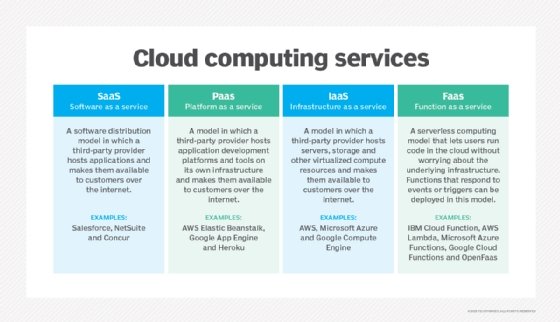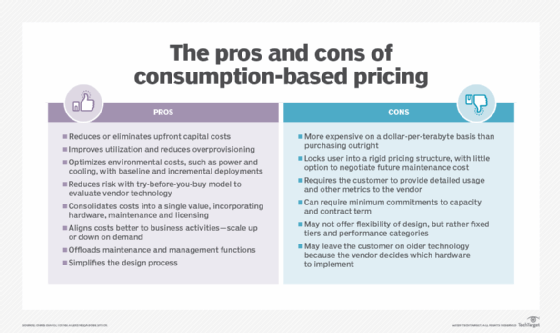consumption-based pricing model
What is a consumption-based pricing model?
A consumption-based pricing model is a service provision and payment scheme in which the customer pays according to the resources used. The provider tracks how much the customer uses and then bills them for the amount of services consumed. It can also be referred to as pay-as-you-go billing, metered billing or usage-based pricing.
Although relatively new in computing, consumption-based pricing is common in many traditional business types. For example, municipal utility companies, such as water and electricity service, charge consumers a fee based on the amount of the service the customer used.
Consumption pricing is common in cloud computing and utility computing. These are often treated as commodities and may be required to rapidly scale up and down based on demand. Platform as a service (PaaS) and infrastructure as a service (IaaS) often also use consumption pricing to maintain cost advantage and profitability.
Consumption pricing is often in contrast to a subscription price model, where the customer pays the same amount for access to a service regardless of how much or little of the service used. An example of subscription service is cable television, where customers pay the same amount per month regardless of how much television they watch. Software is more often offered as a subscription, but with the emergence of software as a service (SaaS), consumption-based billing for software is being increasingly used.

Common consumption-based pricing models
Consumption-based pricing tracks and bills how much a service is used. The exact details of what is tracked can change from product to product and provider to provider. Most often these are quantitated by time used or amount of a resource. Some providers offer a certain amount of use for free. Sometimes a service may track and bill on several factors at a time, making the total bill difficult for the consumer to predict.
Common consumption billing items
- Compute or CPU. Seconds a virtual machine was active or milliseconds a service was handling a customer request.
- Data transfer. Gigabytes of data that ingress or egress to the provider.
- Data storage. Gigabytes of data held by the provider.
- Uses or queries. Many API service providers will charge based on the number of times the customer accesses it. These may be billed individually or in groups up to 100,000 depending on the service.
- Execution memory. Gigabytes of RAM per second consumed by service. Common in serverless functions.
- Credits. A prepaid amount of service defined by the provider. These are often specialized based on the workload.
- Other. Software may charge based on specific uses. For example, CRM software may charge based on number of customer contacts held in the system.
Consumption-based pricing as a customer
Consumption-based pricing is increasingly attractive for service customers. Consuming a service provided by a vendor removes the capital expense costs of building out their own systems, making it particularly attractive for smaller uses and startups. Paying a single bill is simpler than managing hardware, software and other service costs separately.
It allows the consumer to be more dynamic and provide faster response to market needs. It also makes sense to the bottom line to only pay for capacity as it is used instead of tying up capital in subscriptions or hardware. Additionally, the vendor is highly motivated to assist the customer in using the service, so customer service is often better.

Customers should beware of potential pitfalls of consumption-based pricing. For large uses, it will often be cheaper for the customer to buy their own infrastructure; so a careful total cost of ownership analysis is warranted. Predicting total bill size can be difficult, often resulting in the shock of increasing cloud bills. A misconfiguration in the customer implementation can cause the service to rack up billing while not performing useful work, causing massive bills. The customer may also experience vendor lock-in, making it difficult to switch providers.
Advantages
The consumption-based computing model includes the following advantages:
- reduced start-up capital cost;
- less waste and overprovisioning;
- vendor support is incentivized to help customers use the product;
- lower ecological impact due to vendor economies of scale;
- less startup risk;
- consolidated billing;
- faster resource scaling; and
- simpler system design.
Disadvantages
There are also some disadvantages to this model, such as the following:
- often more expensive than self-built systems;
- rigid pricing;
- vendor lock-in;
- customers have no say in vendor service quality; and
- customers are billed for their wasted activity.
Consumption-based pricing as a provider
Many service providers are considering transitioning from a subscription-based pricing model to a consumption-based one. This is especially true as they begin to offer SaaS solutions. As a service provider itself begins to use more cloud services, using consumption-based pricing can help it align its customer billing and provider costs more accurately.
Consumption-based pricing models often show better customer retention and revenue. It also provides customer use metrics showing opportunities to expand and improve.
See also: flexible consumption models lower IT overhead, help investments and explore the consumption-based IT and Opex storage landscape.






